Chalon-sur-Saône – Tournus
Although there was considerable wind the next morning, we lowered the mast and were resetting the ropes when Andy and Deb (from the barge Molly, against whom we had been rafted through last winter) came over from their boat, coffee cups in hand, to say a quick hello and work out where we might catch up with them in the coming days.
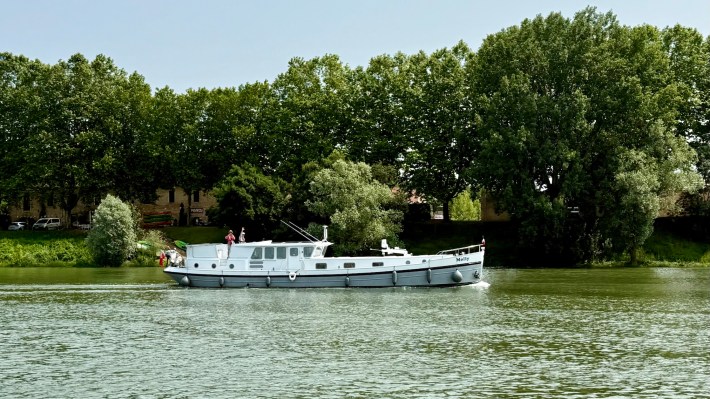
The day remained a little grey and drizzly, as we approached Tournus, the sun came out and we once again secured a spot on a long concrete quay.
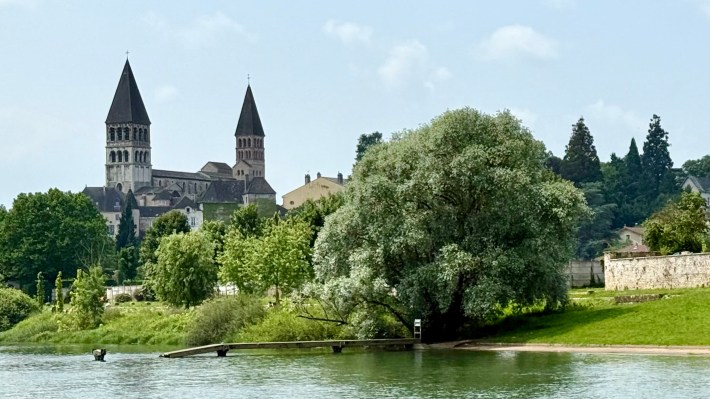
Lisette had to jump down quite a way to get onto the quay.But interestingly, over the next couple of days, the water level dropped by at least half a metre to the point where we could just step off Catharina Elisabeth with ease. We haven’t seen that degree of change on a river before.
Our mooring was attractive with trees and well-kept houses above us and a reasonably quiet road alongside. Over the following days, we mostly had the mooring to ourselves. Three hotel boats (not the big Vikings) came and left and a couple of other pleasure craft came and went, staying for only a day. We did meet Aussies Sheree and Paul Willems on Spes who were travelling in convoy with a smaller boat that Paul’s parents had bought so they could travel with them this season. As they were both working and had family, we didn’t get an opportunity to have a long chat but it was nice to put faces to names we knew.
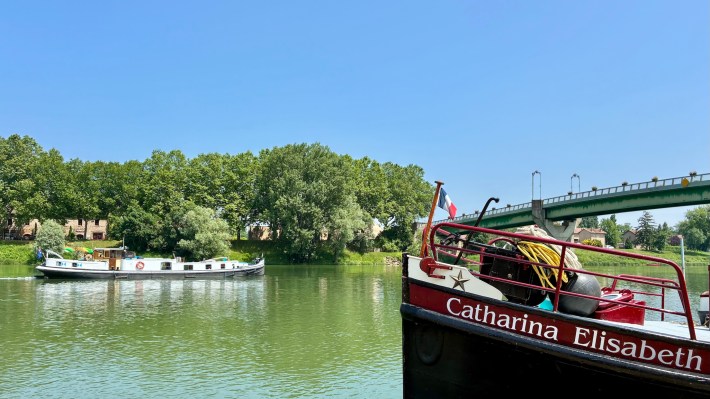
A boat came into moor one day, and I immediately recognised the boat by the Captain Haddock, standing proud at the bow. The owners were French, but we did have a nice conversation about the boat and its rather unusual figurehead. They said that it was simply a gift from a friend. We had passed this boat last year on the River Doubs but I was unable to get a photo at the time. We love all of the Tin Tin stories, and have even visited the museum in Belgium dedicated to the creation of these tales. In fact, we have a number of Tin Tin books on board. All in French. So it was great to see this boat up close and talk to the owners.
The old town of Tournus has pleasant narrow streets that wind up the hill towards the main tourist feature of the town, the abbey of Saint Philbert.
The streets that run through the centre of town are one way, quiet and bordered by plenty of shops – active and well presented.
Overall, a very nice town. Distances are short, and the inclines not too steep, so we mostly walked around. First stop was the Tourist office and then the Abbey, which was just metres further on.
Abbey Saint Philibert
Saint-Valérian, a roman soldier was martyred in 178 AD, one of the first Christian martyrs. This delightful little Romanesque church is dedicated to him.
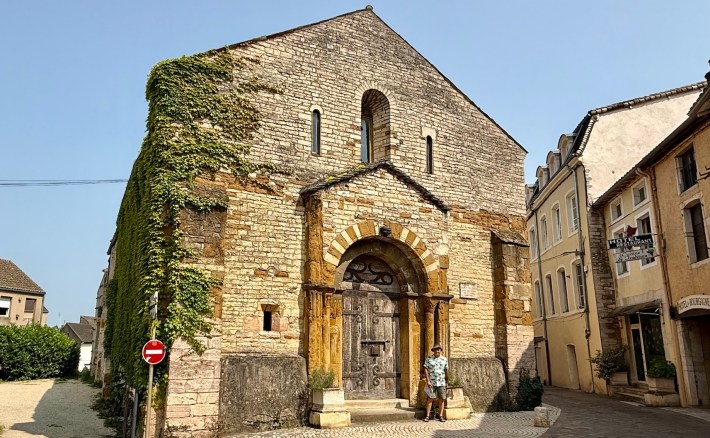
Over the centuries, Saint Valérian’s relics were removed and destroyed, but two hundred years after his death an oratory was built over the site of his tomb, and later a monastery was erected in the 4th Century.
In 854, an Augustinian abbey was founded, situated at the top of the hill and existed as an independent community. It was walled and gated with only limited contact with the village that grew around it.
Falling on hard financial times, in 875 the monks of Saint-Valérien offered refuge to another group of monks. These were dedicated to Saint-Philibert and were moving from place to place in France carrying the remains of their saint with them trying to avoid the marauding Vikings. The abbey became a Benedictine abbey for both saints. And much later on, a parish church in 1802.
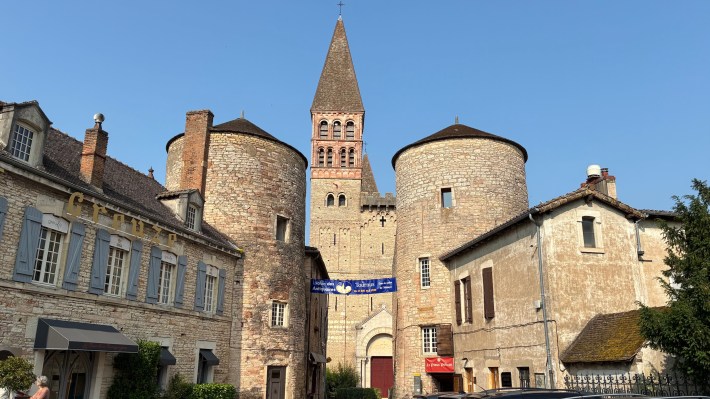
It was cool and, as is sometimes the case in French churches, rather dark inside but it was impressively big and well cared for. As we walked around, continuous organ and trumpet music filled the nave delivering us a serene atmosphere.

The main part of the church had the usual interesting collection of statues of saints (although Jeanne was nowhere to be seen) and stained glass windows.
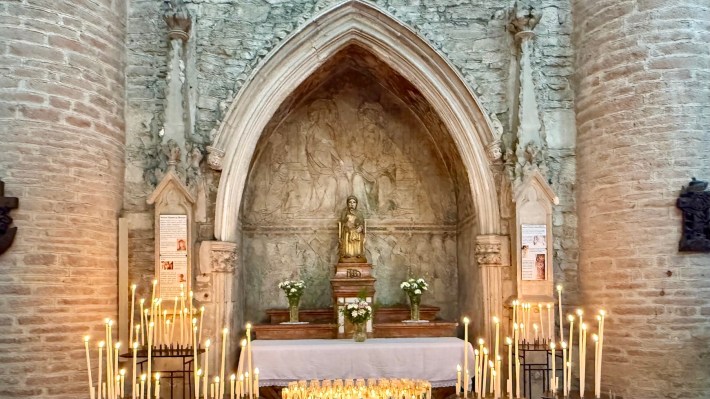
At the nave end of there was a wonderful mosaic that had been discovered fairly recently and the best part exposed for viewing. Originally it would have swept all around the nave area. It was composed of the signs of the zodiac and linked to the passing of the seasons.
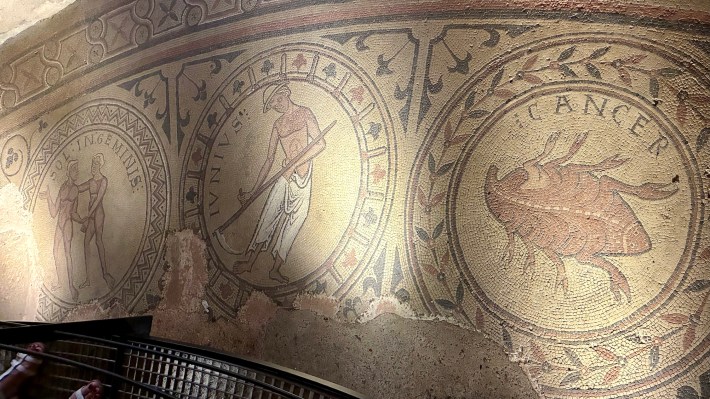
Nearby, there was a set of stairs that led down to the crypt which was one of the most architectural we have yet explored. It was in essence a small church of its own with a central hall surrounded by a number of chapels.
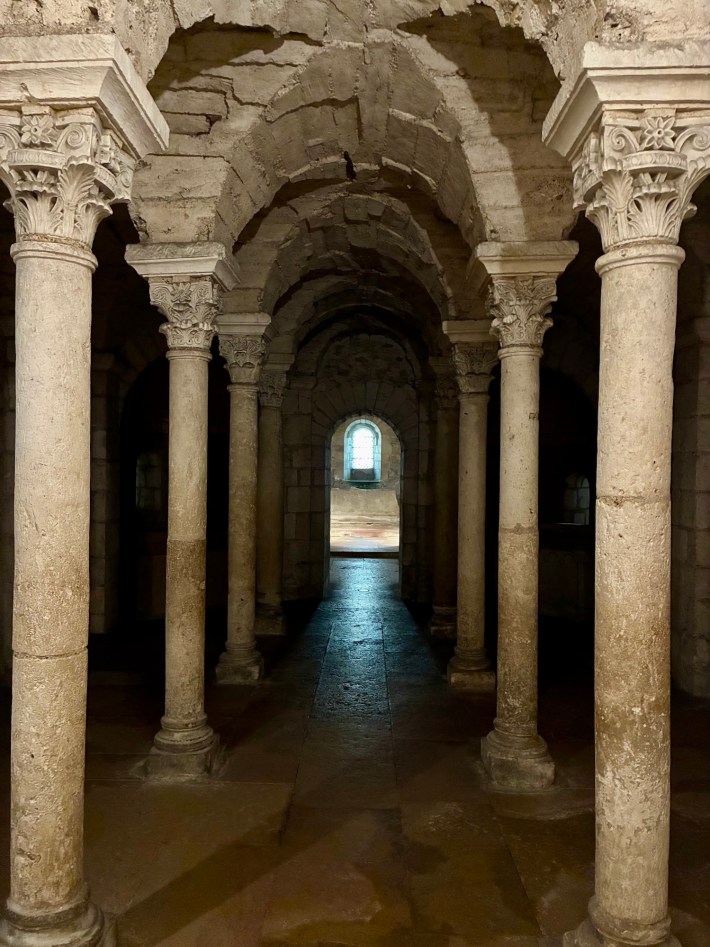
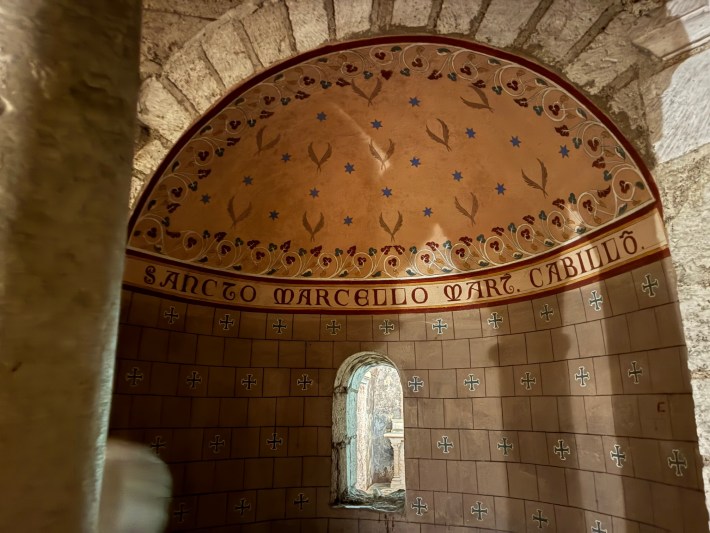
Back up the steps into the main abbey we spotted another door leading up a curved staircase to the Chapel of Saint-Michel which sat above and behind the main church. This was filled with a series of explanatory posters about the life and times of the abbey,
and another set of steps, gated off, that presumably gave access to the belfry in the north tower.
We also noted a poster for a choral concert that was to take place on the Friday I was very keen to see this and convinced Ian that we should stay an extra day so we could enjoy it.
***
Visiting the Gendarmerie
We had cycled along the road beside the river to get groceries, and while there, Ian decided beer and wine here was an excellent price, so once we took our (non-alcoholic) supplies back to the boat, Ian took off again while I started dinner preparations. He picked up his wallet and rode off, returning a short time later with bulging panniers and a backpack of supplies. The following morning Ian saw a number of notifications that suggested one of us had been buying up big at Temu and Shein. Since I have never shopped at these online stores, and Ian said it was not him, we realised his card had been used overnight. Turns out the wallet must have fallen from his pocket as he rode along the evening before, but when he couldn’t find it at the supermarket, he simply assumed he had not taken it at all, and paid with his phone. We hold little in the debit card, seeding it as we go, so there was not much for the thieves to get, but they seemed to be purchasing gift cards, all of equal value, which I now learn is a common use of stolen cards.
Quickly blocking the cards (a debit and a credit card), Ian spent quite some time on the phone to discuss cancellations, new cards… We knew that to claim the losses we would need a police report, but we were booked into a lovely restaurant for my birthday lunch, so we put on our happy faces and had a most delightful lunch. My card is separate to Ian’s so it was fine to use, but we were going to need a debit card to withdraw cash from time to time. France has several different types of police, and we had two tries at getting into the ‘police municipal’ in town. Eventually spoke to someone who told us we had to talk to the gendarmerie, which was several km away, just outside Tournus. A long hot walk later, and a very thorough ‘audition’ as the French call it, we had our statement, Ian sent it off to the bank and within the hour, all our money refunded.
Aux Terrasses
Lisette’s birthday came around during this stay and, acting on a recommendation from over five years ago from Don and the late Cathy-Jo on Oldtimer, we decided to treat ourselves to our first dining experience in a Michelin starred restaurant, Aux Terrasses.
We opted for déjeuner (lunch) as a more affordable menu choice of €45 per person was available. It was a truly memorable meal from many perspectives. The ambience was clean and the room tastefully decorated. Certainly the food was delicious, a treat for the eyes and presented with incredible care. Each course was delivered by two waiters, each one carrying the dishes for one of us. The dishes were then described to us in great detail, most of which Lisette could understand. We had a bottle of local white wine and this also was delivered with care and attention by the sommelier. As we finished eating and Lisette opted for coffee, we were invited to take the last of our wine and her coffee in the sunny garden outside. It’s not something we will probably do often but it was an unforgettable experience. Here’s the full suite of photos.
Hotel Dieu
Tournus has a well cared for hotel dieu – these were institutions set up to care for the poor when they became sick. Generally they were run by religious orders but financed by well-off members of society.
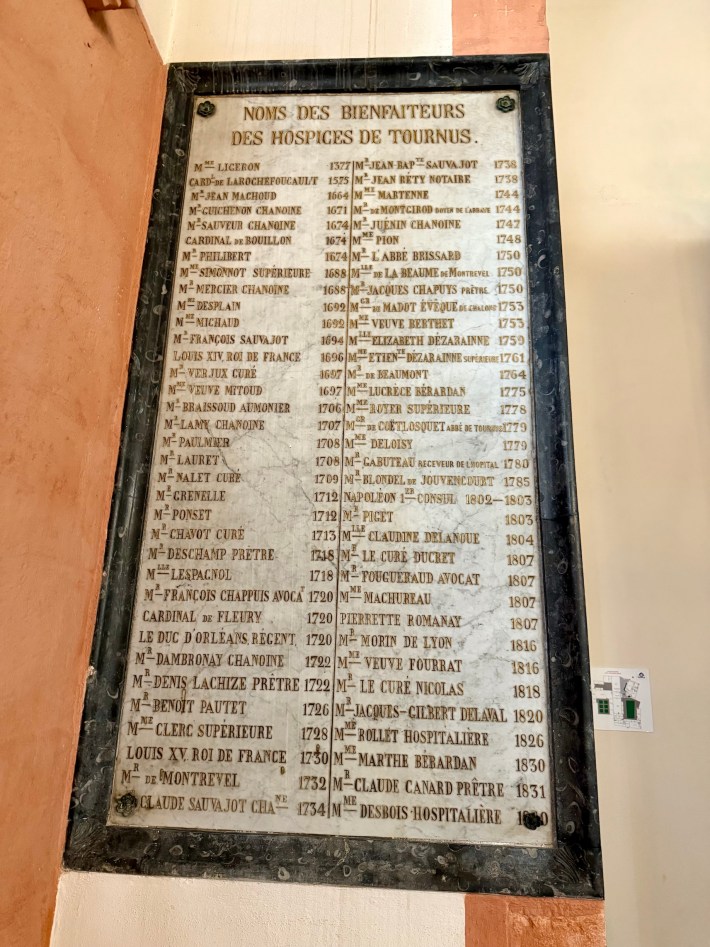
The one in Tournus, we were told by a very earnest, attentive and fast French-speaking attendant was far more authentic than the much-lauded one in Beaune (which we had very much enjoyed last year) because the latter was mostly a restoration after much was destroyed by fire. The one in Tournus was basically in (refurbished) original condition. The layout of the hospital beds was the same as in Beaune – small cubicles with drapes in front for privacy and access to deliver treatments through a door in the back.

Treatment was pretty basic mainly consisting of clearing out bad humours, (several impressive devices for delivering enemas were on display) and feeding the sick with nourishing food.
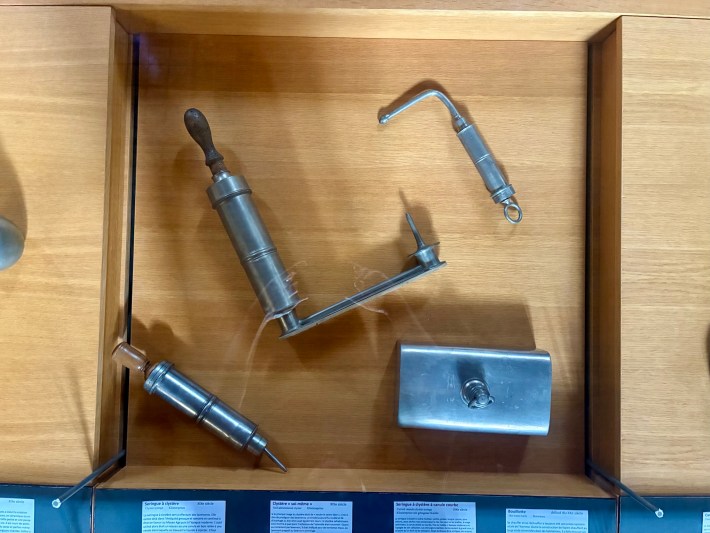
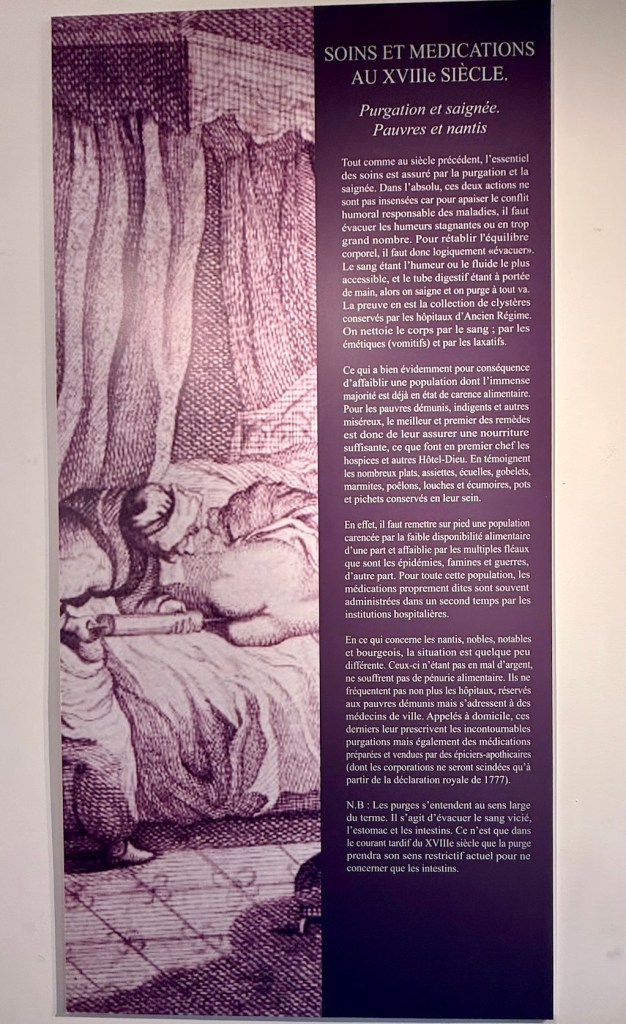
Purging and bloodletting.
As in the previous century, most healthcare consisted of purging and bloodletting. In absolute terms, these two practices were not entirely without sense, as in order to alleviate the humoral conflict responsible for disease, it was necessary to remove stagnant or excess humours. To restore the body’s balance, it was therefore logical to ‘remove’ them.”
There was an apothecary room filled with jars of diverse extracts
which had a painted wooden ceiling, apparently only recently re-discovered during renovations.
Another room contained a display of the history of the hotel dieu with several interesting insights into how it operated. One gruesome balm was called graisse humaine – human fat. Otherwise known as ‘hangman’s fat’ it had a reputation for strengthening limbs, easing pain and restoring contractures. It was purchased from executioners although the means of producing it, thankfully, was not described. Leeches were also a feature of treatments at that time, and continue to this day. But the logistical issues associated with using them routinely was challenging. They were hard to keep and had to be discarded after each use. To obtain more, they were collected by fishermen who waded out into leech-infested water, and then removed the attached leeches from their limbs and placed them in water. It was dreadful work, done in humid conditions and the collectors ran the risk of fainting from loss of blood. Apparently, it was considered women’s work.
Greuze
While here we came across a new (to us) famous French painter, Jean-Baptiste Greuze. He was born in Tournus in 1725 and so this year marked his tricentennial. The town had a set of stands on the riverside featuring some of his portrait paintings, throughout the town there were other displays where the facades of buildings had been painted with copies of his works.
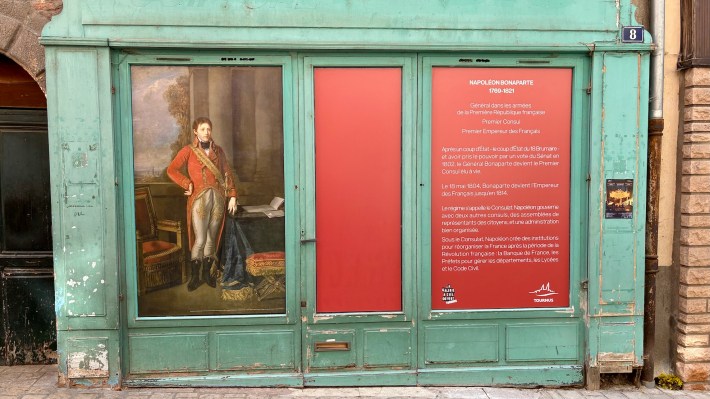
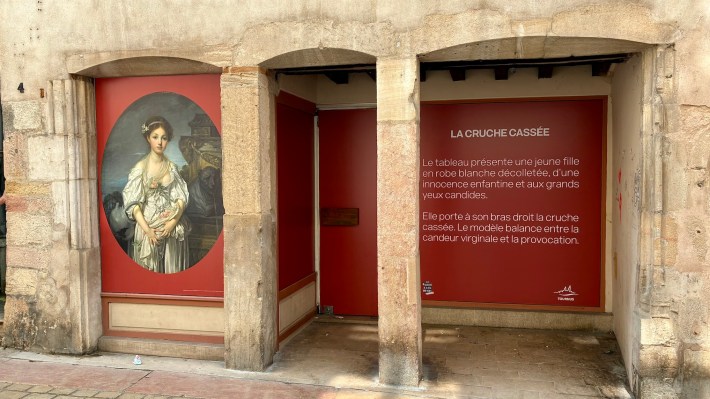
There was also a display in the local museum.
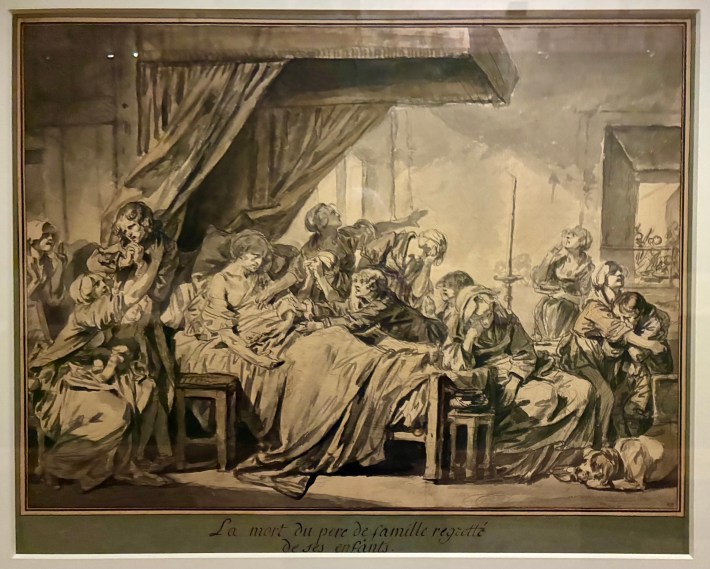

He was an accomplished portrait and ‘genre’ – the latter category refers to painting a subject based on an idea rather that reality. Grueze aspired to be recognised as a ‘history’ painter whereby the work illustrates some aspect of real, historical life. However, the French Academy rejected the works Greuze submitted for this category and he withdrew from the Academy. He was popular and at one point quite wealthy, but died in poverty during the latter stages of the French Revolution.
Mozart Concert
Having purchased tickets for the concert, at a very modest price (€18), we ate on board before walking up through the winding streets to the Abbey. It was well attended but not difficult to find seats only a few rows from the performance area. The choral group were fronted by a moderate sized orchestra, with four soloists. Three had roles throughout the masse, two sopranos and a tenor, but at the very end, a baritone featured with the other three for a final burst.
Lasting about two hours, and despite the intensely warm evening, the performance was superb. I enjoyed it immensely, and Ian enjoyed the parts for which he was gently prodded awake. (His excuse is generally ‘post-prandial’, but increasingly I suspect it to simply be ‘sitting down, doze off’.) Strolling back to Catharina, we both felt we had done more than justice to this pretty town. And so to bed.
The following morning, would see us setting off for our next stop – Mâcon.
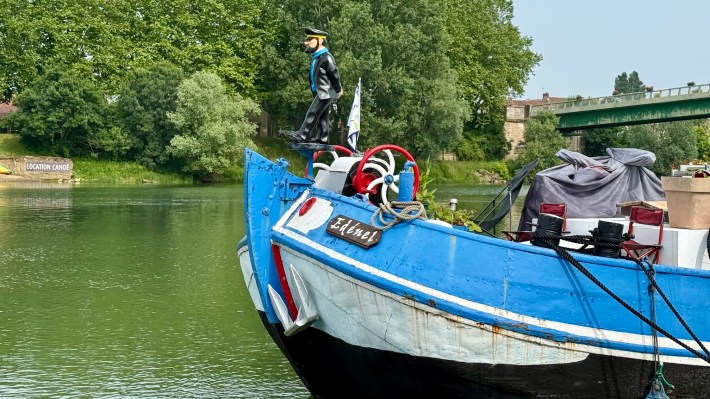
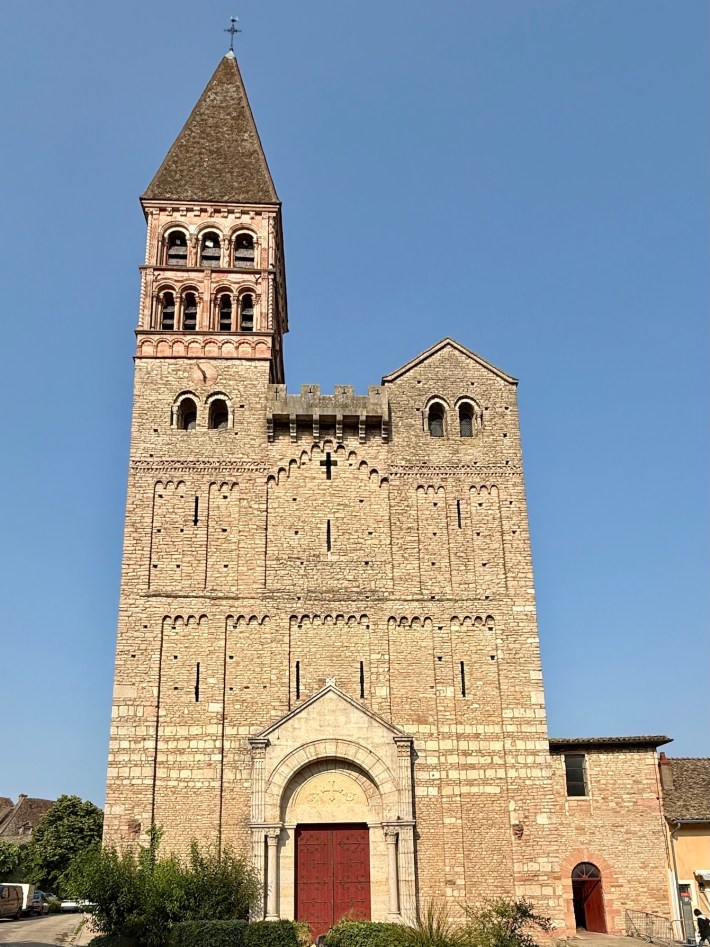
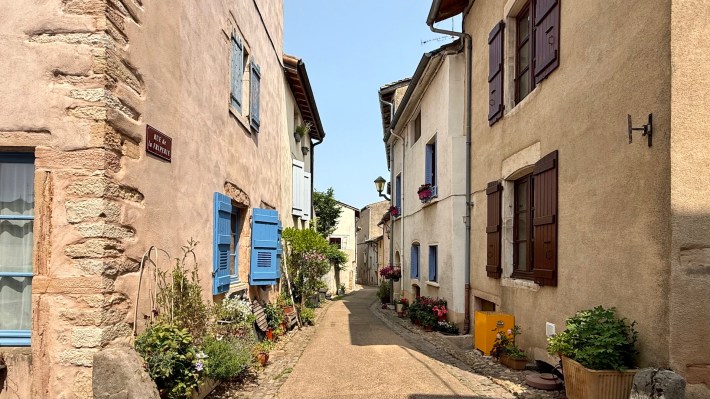
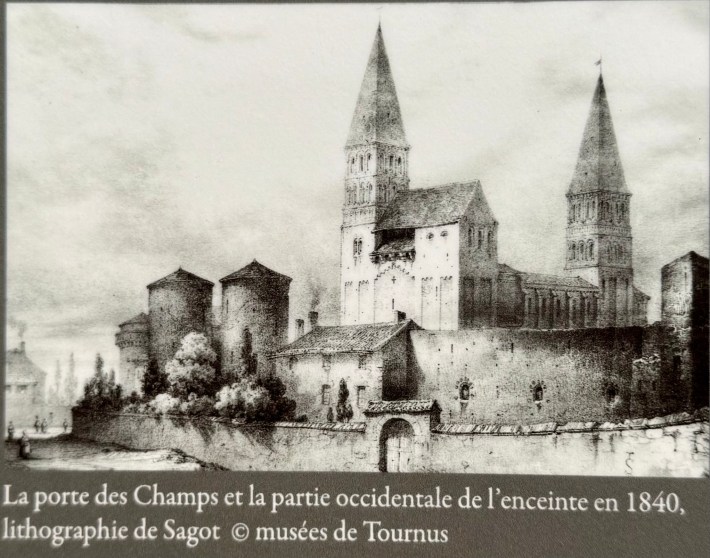

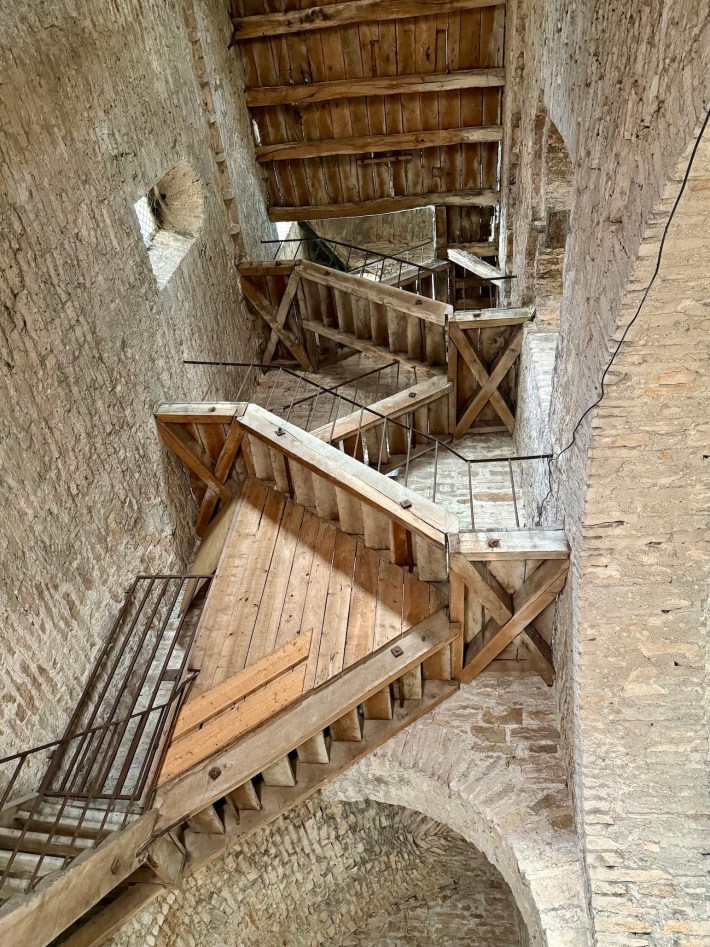
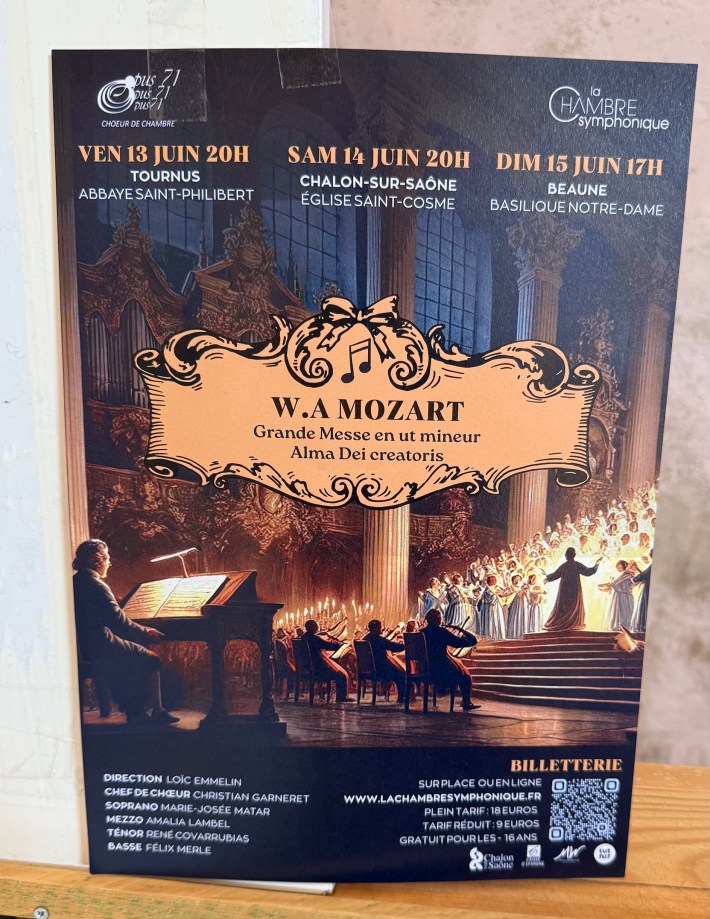
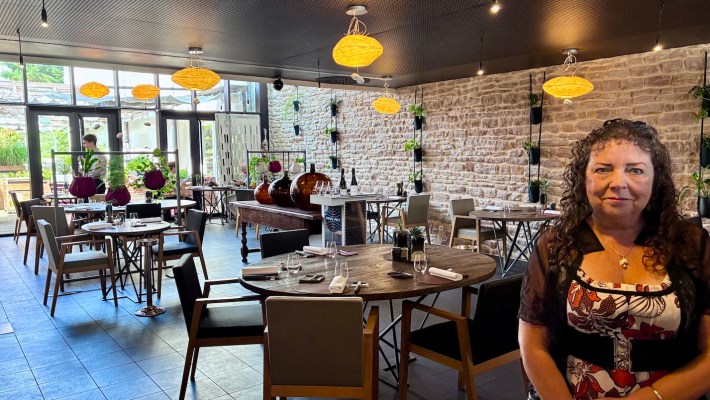
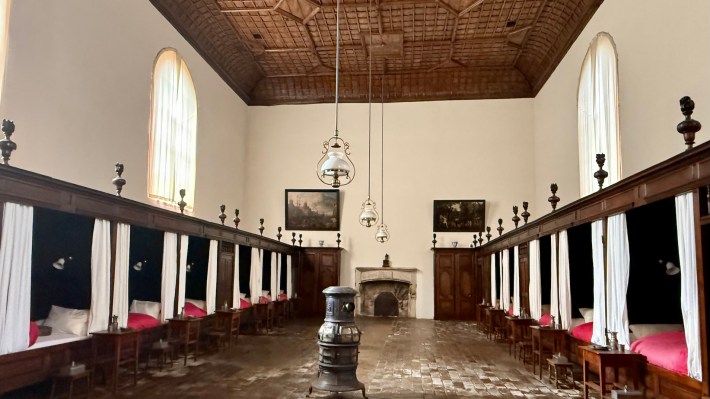
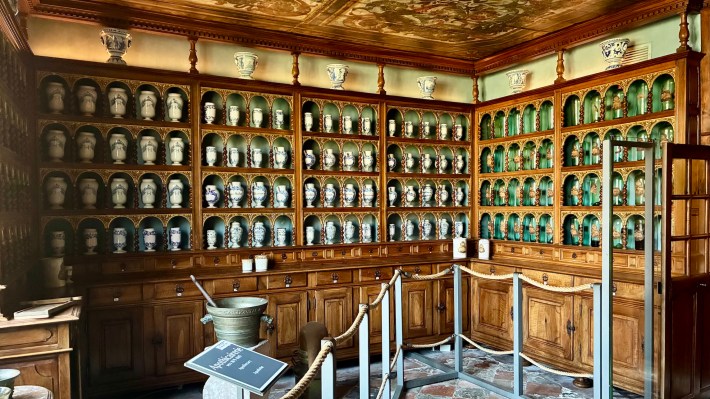
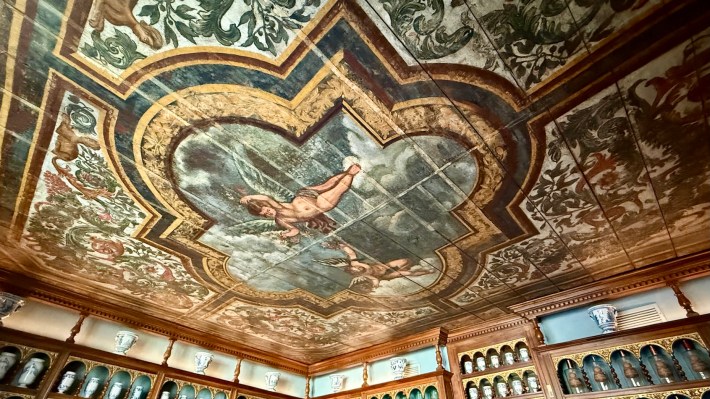



4 Responses
What a beautiful experience for your birthday
Lisette and it will be something to remember. You were so lucky about losing your card and getting a great response from the bank . The description you give to everywhere you go is so informative and it is like reading a tourist magazine. The photos and your endless knowledge of the towns and
surrounding is unbelievable. Looking forward to your next mooring.
We are having so much fun, Mary, that the blog entries do suffer somewhat. I have drafted the next one, now some representative photos must be chosen. But we are doing better than last year, or any other year for that matter. At least we are writing as we go along. I make notes in the log book which help identify which memories belong where, haha.
Hi Lisette and Ian,
I’m reaching out for a little advice – suggested by Simon Evans. We (Chris Dewhirst and Heather Martin from Mullumbimby Australia) have purchased a Piper barge, now called Clancy (previously Lady Sue) and are looking to swap out the six gel house batteries for lithium batteries, but keeping the gel starter motor and bow thruster batteries. Simon said that you made the change over. Was it complicated? Kind Regards Chris Dewhirst
My email is chrsdewhirst@gmail.com and my website is everestgunsandmoney.com.au
Hi Chris, I’ll certainly get in contact. “Complicated” is a pretty loaded term, but if I was able to do it, it doesn’t require much in the way of technical skill; it mostly requires some research and planning.